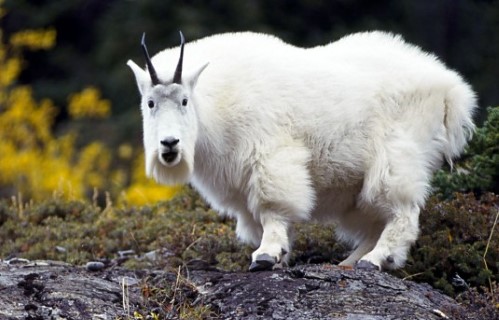The Mountain Goat, known scientifically as Oreamnos americanus and colloquially as the Rocky Mountain Goat, is an emblem of North America's rugged wilderness, where it navigates the sub-alpine and alpine landscapes with remarkable agility and grace.
This majestic creature, native only to North America, epitomizes adaptability to its high-altitude habitat, where it roams the Rocky Mountains, Cascade Range, and other western mountain regions. From the craggy cliffs to icy terrains, the Mountain Goat's woolly white double coat, consisting of a dense undercoat and longer outer hairs, shields it from the elements, allowing it to withstand temperatures plunging as low as -50°F (-46°C) and winds roaring at speeds of up to 100 mph (160 km/h).
Standing at approximately 1 meter (3.3 feet) at the shoulder to the waist, with males (Bucks) outweighing females (Nannies) by up to 30%, the Mountain Goat is a sight to behold. These magnificent creatures can weigh between 45 and 140 kg (99 and 309 lb), with males often sporting longer horns and beards, adding to their imposing presence.
With cloven hooves perfectly adapted for scaling steep slopes with pitches exceeding 60°, the Mountain Goat navigates its rugged terrain with unparalleled skill. Their sharp dew claws provide added traction, ensuring sure-footedness even on the most precarious precipices.
Their diet, consisting of grasses, herbs, sedges, ferns, mosses, lichens, and the foliage of low-growing shrubs and conifers, sustains them in their alpine abode. In captivity, their palate expands to include grains, alfalfa, fruits, and vegetables, underscoring their adaptability to various environments.
In the wild, Mountain Goats live a modest yet impactful 12 to 15 years, their lifespans limited by the wearing down of their teeth, a testament to the challenges of their rugged existence.
Despite their name, Mountain Goats do not belong to the genus Capra like their domestic counterparts. Instead, they are part of the order Artiodactyla and the family Bovidae, along with antelopes, gazelles, and cattle, belonging specifically to the subfamily Caprinae.
The Mountain Goat, a solitary yet resilient inhabitant of North America's towering peaks, embodies the indomitable spirit of wilderness and stands as a testament to nature's enduring beauty and complexity.
